Viewership in review
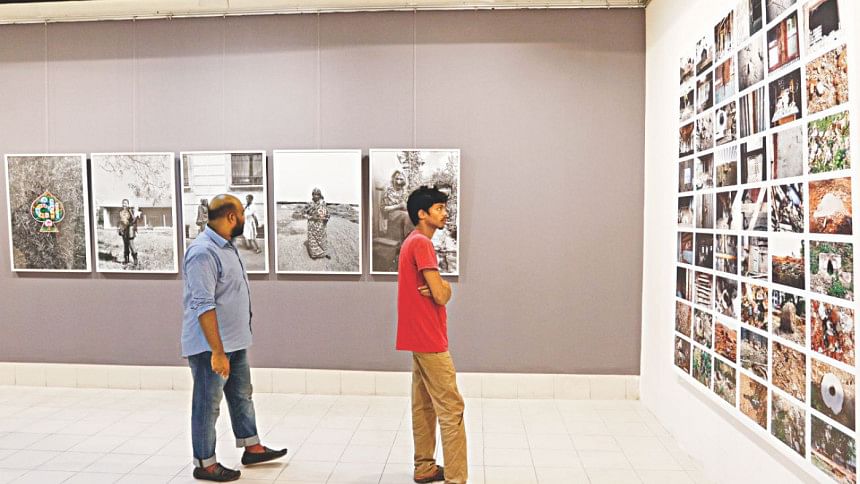
As you enter one of the inner rooms of Shilpakala's Gallery-1, you notice a television with a tap attached to its screen. From it, red liquid continually flows down into what looks like a bloodied pitcher. It is set against a wall collaged with war photos. On the TV screen, scenes of bombing and destruction surface in regular intervals. One could, at any time, turn it all off using the remote control quietly hidden behind the pitcher. But nobody dares to. Everybody stares at the spectacle that is Imran Hossain Piplu's Story of Red River and Grey World (2018). It's a scathing critique of the how broadcast media has made a spectacle out of global tragedies—an extension of which is realised when crisis-struck news segments are rewarded with the highest Television Rating Points (TRPs).
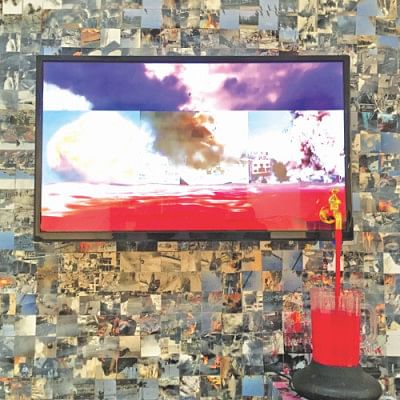
The tap in Piplu's work is one of those magic-trick toys being sold in roadside hawker's markets—you can see water continually flow down from it into a pitcher, but there's no waterpipe connected anywhere. When I first saw one of these in the market a while back, I was boggled. I searched for the source of water, looked inside and tried to figure out the mechanism, and expose the magic trick. Similarly, perhaps, the visitors of the Biennale were perplexed as to how this works—where is that goddamn bloody water coming from? The screen, displaying a river of red, cannot be the source. And while most of us dismissed it as a full-proof trick, few curious onlookers wouldn't let it rest. I witnessed one such visitor going forward with his index finger pointed out. He flicked his finger at the running water, hitting what seemed like a transparent pipe, and then splashing red all over the wallpaper made of war photos. This was probably the single most exciting moment of my art-viewing experience, one which I will narrate for years to come.
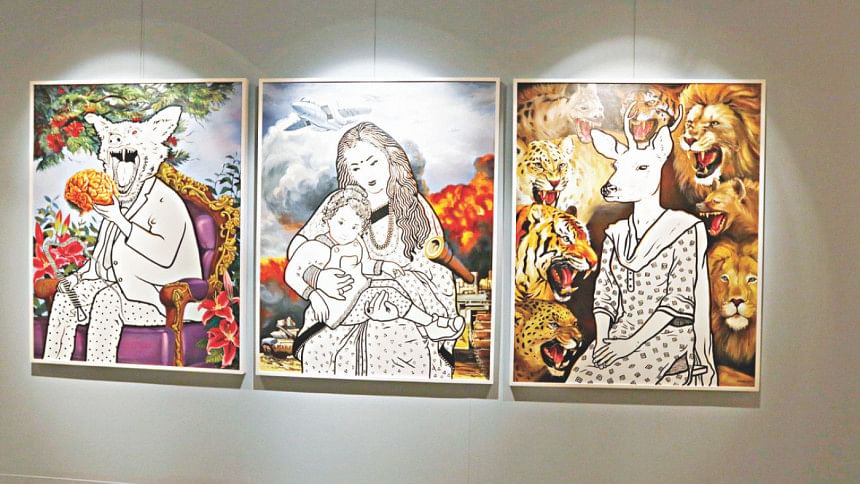
Perhaps I could write about how this act took the artist's work a step ahead, the red liquid bloodying the war-struck wallpaper, spilling some more on the floor, suggestive of blood stains. Yet, I know, being present at the moment, that this act truly unfolded from the naïvety of that man who didn't know any better and only acted upon his curiosity, much like I did when I saw one of these taps in the hawker's market. I wonder if the artist had thought of the possibility of someone testing the installation. I surely hope that he did because the man I witnessed was not the only one, plenty others were sneaking chances at "exposing" this art-trick. Perhaps these are people who are not familiar with the "do not touch" motto of museums: the interaction of art with this sort of audience, as observed in the incident above, produces a remarkable critique of the space of exhibition itself.
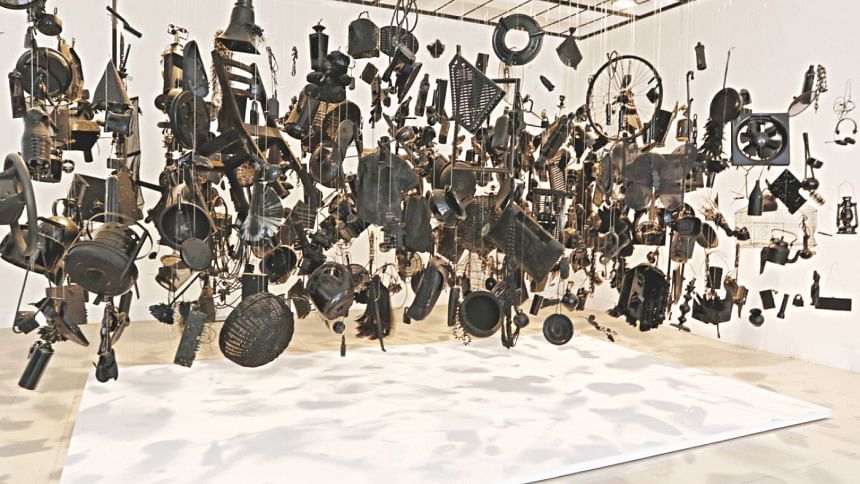
This is the juxtaposition upon which the 18th Asian Art Biennale sets itself—the paradox of high art and "mainstream" viewership. The lack of opportunities to interact with institutionalised fine art creates an aesthetic perception free of any established notion of what should be considered (good) art. Majority of the viewers are unfamiliar with theories of form, medium, and aesthetes. Their likeness towards any art-pieces is directed by their natural instinct. And that exact genuineness disturbs the pretence of high-art. In this way, it feels like the Biennale itself embodies the classic debate on viewership. And in this public domain, artists are faced with the challenge of how their concepts can be pared down to appeal to an audience beyond the art community.
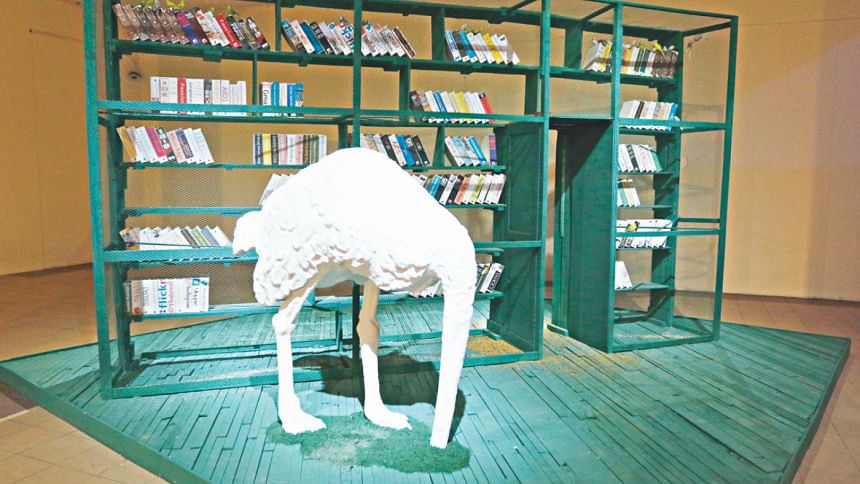
Mohammad Hasanur Rahman (Reaz)'s Traumatized World (2018) explores this discourse even further. Traumatized World is a large-scale installation that puts a caged library together as backdrop to a sculpture of an ostrich with its head in sand. The library is host to small birds with enough room to fly around "freely" and maybe even "read" one of the books with heavy titles such as "democracy", "fascism", etc. but ultimately, the creatures are stuck inside the cage just like those ideas and concepts. The larger-than-life piece presents expressions such as "caged bird" and "ostrich with head in sand" in a literal form that can be easily comprehended by any and every visitor. Yet, some of its finer detail is reserved for the English-literate audience only: the labels on the books. The loaded titles written in English are only comprehensible by the already linguistically privileged, as if the artist is employing an irony on who has the privilege of viewership of this work.
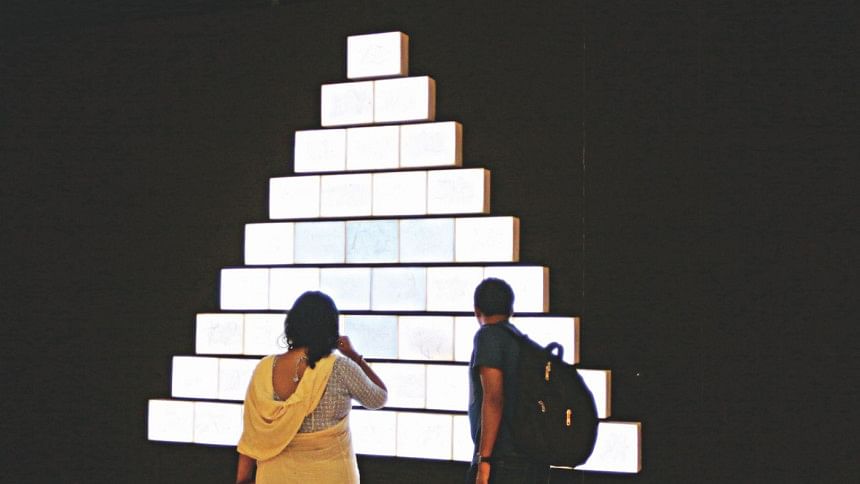
On the other hand, works such as Life in a Frying Pan (2018) by Mehedi Hassan employ a blunt tone to address the disparity in its audience. The artwork depicts a wall lined with rows of black frying pans containing an egg. The wall-text reads, "eggs seemingly remain the same eggs for all…yet, [it] tells us a lot about who we are…and where we belong in the social hierarchy." This speaks on a universal level that people can relate to: eggs = breakfast = regular life—but with an added dimension of locality: it matters if the egg is served in a five-star hotel or at a roadside stall, even though they are all cooked in the same black frying pan. The work dramatises this imbalance in society by pinpointing the imbalance in its viewership.
The use of a common object to strike a universal chord could also be observed in Bipasha Hayat's Embedded Memories and their Shadows (2018), a piece which takes up a Subodh Gupta-styled celebration of the mundane. Hayat hangs various common objects, such as a hairdryer, a cooking pot, a TV, a bag—all painted in black—to represent the clutter of details resting in one's unconscious mind. What I find interesting about this piece is the reminder that memory is "embedded" in our materialist culture—at least for individuals in post-colonial, late-capitalist societies who tend to form meaning through exchange of commodity.
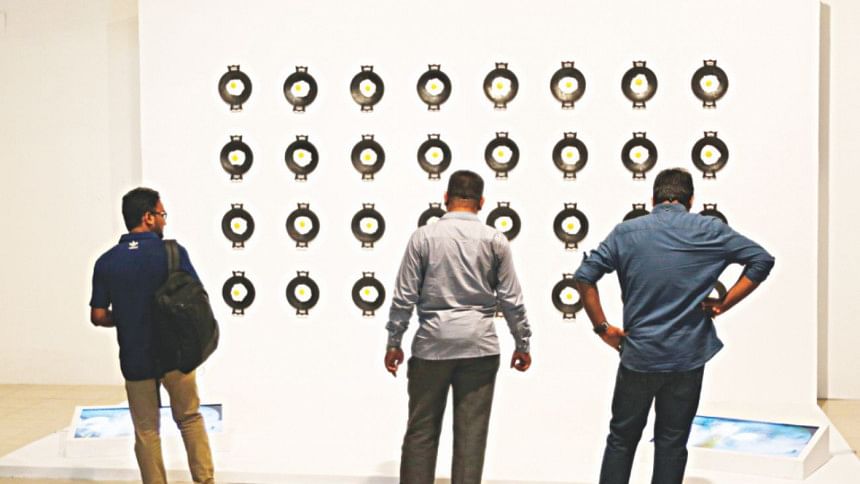
Next to these two works, a smaller gallery hosts Bindu Bishorgo, a project curated by Bishwajit Goswami which brings together 12 young artists with a common theme of developing aesthetics in relation to socio-ecological and political landscapes. The artists then imagined, explored, and portrayed the state of their surrounding within the limits of their chosen discipline. Prosun Haldar's Situation or Compromisation (2018) is reminiscent of Kehinde Wiley's subversive portraits—except further complicated through its animalisation of classic motifs such as of Mary and Baby Jesus. Kuntal Barai's gridded painting on the gallery's ceiling, titled Displaced (2018) dapples, with concepts of (controlled) space and how it can manufacture the viewing experience. Kutubul Ismal Ovi's micro-sculptures on pencil graphite plays on the manipulation and subversion of scale that can direct the viewer's focus as per the artist's will.
Bindu Bishorgo is exciting from an art-historical perspective due to its research-based and academic approach to the fine arts—something I have been dismissing as elitist hullaballoo thus far. But what makes this academic art still enjoyable is the curator's ability to contextualise what may be otherwise difficult concepts. A curatorial framework guides how this joint-exhibition can be viewed by providing textual accompaniments, photo archives of the art process, and video compilation of artists' statements—although it must be noted that it was all in English—which help visitors understand what the art projects may stand for, thus, making the viewing experience more enriching.
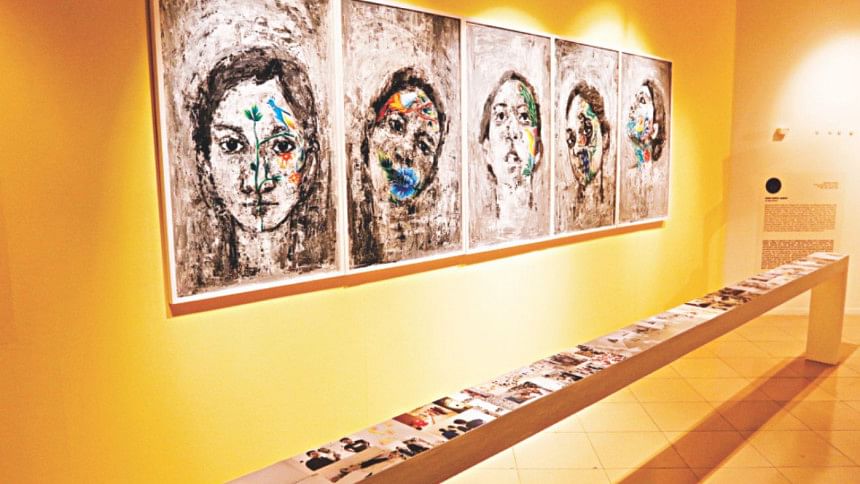
Bindu Bishorgo's curatorial style is appreciable considering how many of the other galleries were curated, or not curated, if I may say. Some of the galleries in the Biennale were simply clusters of frames and canvases while most lacked any curatorial note or wall text. Especially when viewing art in its abstract and surreal forms, the lack of contextualisation exhibits the alienating "art for art's sake" approach and overlooks public art's social function. This begs a deep question from the Biennale at large: what is the purpose of this extravagant affair of art and culture then?
Sometimes it feels as though the Biennale is a navel-grazing moment for artists to impress their peers and uphold the traditional gateways of creative and intellectual elitism. Other times, it feels that the summit is for foreigners, banking on local artists to establish a market of some kind—fetching a price tag for the "Bangladesh" label—that can help art collectors profit on their investments. In both times, the conversation is restricted to the privileged classes and that is apparent in how the exhibitions are curated—be it separate washrooms for foreigners, the emphasis on form and theory, having mostly non-interactive art, the printing of submissions and proposals as wall-texts, wall-texts written only in English, or no wall-texts at all! The middle ground for a two-way education or engagement with the plainsman often dies down amidst the fanfare of grand-scale, appreciation-centric art projects in these huge exhibitions.
It is not to say that the Biennale is completely exclusive and selective. Quite the opposite. The best part of the Biennale is how open it is to a non-art audience. The state-sponsored Asian Art Biennale, revived under new leadership, is a riveting platform for artists to introduce their aesthetical and ideological projects to a wider audience. My only concern is, do they actually want to do that?
This is not an exhaustive list, and neither are the mentioned titles the only notable artworks. It is beyond the scope of this article to explore all note-worthy projects.
18th Asian Art Biennale runs September 1-30, 2018 at Shilpakala National Art Gallery from 11am-8pm.
Sarah Nafisa Shahid studied Art-History at McGill University, Canada and is a columnist of Star Weekend. Follow @I_Own_The_Sky on twitter for more art and film commentary from the writer.





Comments